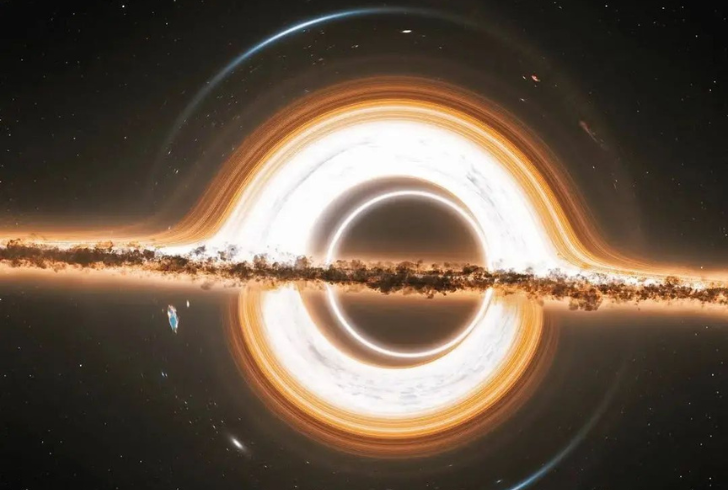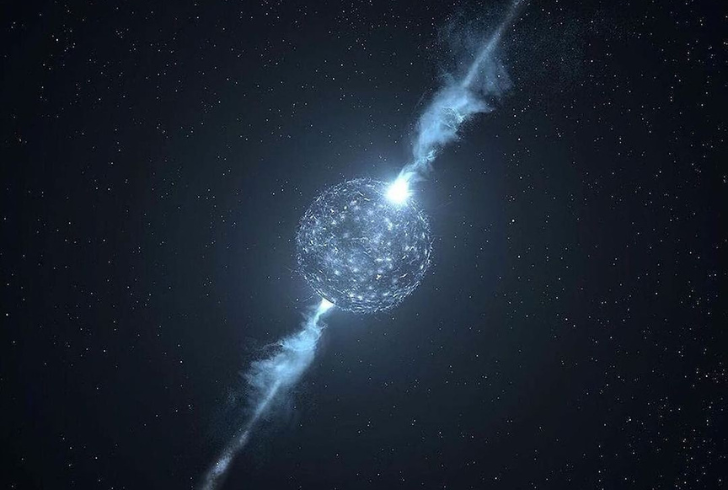But even the most brilliant minds aren’t immune to the occasional misstep. So, join us on a captivating journey through the cosmos, where we’ll witness 7 dazzling confirmations of Einstein’s foresight and explore 1 instance where the universe threw him a curveball.
1. The Cosmic Ballet of Wobbly Black Holes

Instagram | astro.voyagers | Massive black holes, spiraling ever nearer, entwined in a gravitational ballet.
Imagine two black holes, locked in a gravitational waltz, their immense gravity warping the very fabric of spacetime around them. As they spiral closer, their dance intensifies, their movements influenced by an unseen force. This, in essence, is what scientists observed in 2022, studying the gravitational waves emitted by a pair of colliding black holes.
The data revealed a subtle “wobble” in their orbits, precisely aligning with Einstein’s predictions about how objects should behave in the presence of extreme gravity. It’s a cosmic ballet choreographed by the maestro himself, Einstein.
2. The “Dancing” Star and the Black Hole’s Embrace
For 27 years, astronomers have been captivated by the story of a star locked in a breathtakingly close orbit around a supermassive black hole. As it completes each loop, the star’s path deviates from a perfect ellipse, instead tracing a mesmerizing “rosette” pattern. This intricate dance, observed in 2023, is a testament to Einstein’s theory of general relativity, showcasing how spacetime bends around a massive object, influencing the trajectory of anything caught in its grip. The black hole may be the gravitational behemoth, but it’s Einstein’s equations that truly orchestrate this cosmic spectacle.
3. The Universe’s Magnifying Glass
Imagine a cosmic magnifying glass, powerful enough to peer into the farthest reaches of the universe. That’s the essence of gravitational lensing, a phenomenon predicted by Einstein where massive objects bend spacetime, warping the light that passes by them. This cosmic trickery allows us to see objects billions of light-years away, offering glimpses into the universe’s infancy. The James Webb Space Telescope, with its unprecedented power, has harnessed this effect to capture breathtaking deep-field images, pushing the boundaries of our cosmic understanding.
4. The Ethereal Glow of an Einstein Ring
Sometimes, the universe paints its wonders in ways that leave us speechless. One such marvel is the “Einstein ring,” a perfect halo of light formed when the gravity of a massive foreground object bends the light from a distant source. These celestial gems, scattered across the cosmos, are living testaments to Einstein’s theory of general relativity, offering a glimpse into the intricate dance of gravity and light.
5. The Tug-of-War Between a Neutron Star and a White Dwarf

Instagram | astronomhub | The neutron star’s gravitational pull warping spacetime, influencing the trajectory of the white dwarf.
It’s not just black holes that bend spacetime; even the ultra-dense husks of dead stars, known as neutron stars, can exert this gravitational influence. In 2020, scientists studied the 20-year dance between a neutron star and a white dwarf, witnessing a subtle shift in their orbit over time.
This drift, attributed to an effect called “frame dragging,” aligns perfectly with Einstein’s predictions. The white dwarf, though smaller, tugs on spacetime enough to alter the neutron star’s path, once again showcasing the remarkable accuracy of Einstein’s vision.
6. The Universe’s Symphony of Redshift
As light travels across the vast expanse of the universe, its wavelength stretches, causing a phenomenon known as redshift. Einstein not only predicted this expansion of the universe but also proposed a type of “gravitational redshift” caused by the warping of spacetime around massive objects.
In 2011, scientists confirmed this prediction, analyzing the light from hundreds of thousands of distant galaxies. The universe, it seems, sings a symphony of redshift, each note echoing Einstein’s profound understanding of gravity and light.
7. The Quantum Realm Embraces Relativity
Even in the bizarre world of quantum mechanics, Einstein’s theories hold true. One of the cornerstones of relativity is the constant speed of light in a vacuum. In 2015, researchers confirmed this principle on the tiniest scale, measuring the energy of electrons moving around an atom’s nucleus. Regardless of their direction, the energy difference remained constant, upholding Einstein’s vision even in the quantum realm.